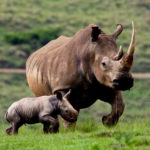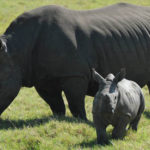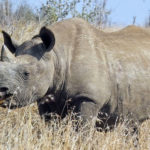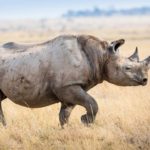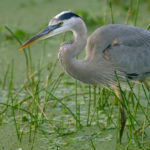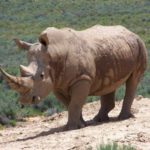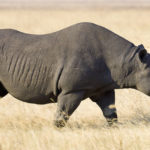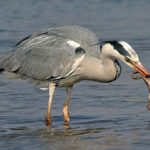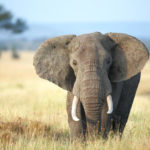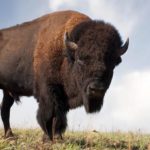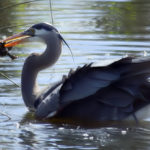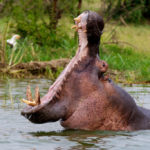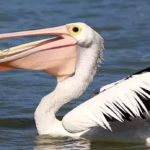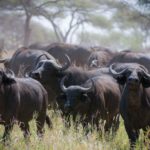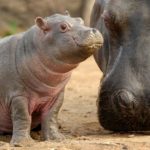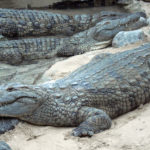Rhinos – information
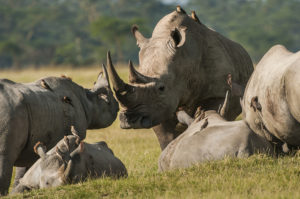 All kinds of these animals feed on herbaceous plants and only the black rhinoceros prefer to bite the branches of shrubs. Watering rhinoceroses visit regularly, in addition, they are very fond of wallowing in dirt and dust. This is probably due to the drying effect of the sun on their bare skin. These animals have harmless friends-freeloaders – buffalo herons and voloklyu. These birds often sit on the backs of rhinoceroses and examine the folds of their skin in search of parasites. Herons, in addition, catch insects in the grass, scared by the giants. Rhinoceroses swim well, but large rivers prefer not to cross. They are asleep, lying down, clumsily bending their legs under them and burrowing their muzzle into the ground.
All kinds of these animals feed on herbaceous plants and only the black rhinoceros prefer to bite the branches of shrubs. Watering rhinoceroses visit regularly, in addition, they are very fond of wallowing in dirt and dust. This is probably due to the drying effect of the sun on their bare skin. These animals have harmless friends-freeloaders – buffalo herons and voloklyu. These birds often sit on the backs of rhinoceroses and examine the folds of their skin in search of parasites. Herons, in addition, catch insects in the grass, scared by the giants. Rhinoceroses swim well, but large rivers prefer not to cross. They are asleep, lying down, clumsily bending their legs under them and burrowing their muzzle into the ground.
There is no specific breeding season for these animals, but their marital behavior is rather unusual. The fact is that fights between males in rhinoceroses are rare, but the opposition between individuals of different sex is very noticeable. During courtship, the male approaches the female, but she drives him away, often very aggressively. And only the perseverance of the boyfriend makes an impression on her and makes him soften. After mating, adults lose all interest to each other. After 15-18 months, the female gives birth to a calf weighing 25-60 kg. The kid at rhinos always has only one, to the light it appears well developed and already in 10 minutes rises on legs. Already at the birth on the snout of the young, a cone is visible, from which the horn begins to grow in the future. The mother feeds him milk for up to a year. Orphaned young rhinos, brought up in captivity, quickly got used to people and behaved very playfully. The kids rushed at the call of the tutor, tried to play with him in catch-ups and kick, as far as the impressive complex allowed them. Females reach sexual maturity in 5-7 years, males at 10-12, these animals live up to 35-50 years.
The only enemy of an adult rhino is a man, lions and hyenas sometimes attack litters. Before the invention of firearms, hunting for a rhinoceros was associated with a great danger for people, therefore, these animals were rarely produced. Nevertheless, horns of rhinoceroses were very much appreciated as a medicinal raw material in Chinese medicine. The myth about the healing properties of this raw material has not been uprooted to this day, although there are no more useful substances in it than in hair.
The first victims of prejudice were Asian species. At present, the number of Indian rhinoceros has decreased to 1,000 individuals (most of the population lives in the Kaziranga reserve). Almost disappeared in the wild nature relict Sumatran rhinoceros, the only hope for the salvation of this species remains breeding in zoos. As for the Javan rhinoceros, the extinction of this species is just a matter of time. In nature there are no more than 30-50 individuals, in captivity of Javan rhinoceros too is extremely small.
Against this backdrop, populations of black and white rhinos, estimated at several tens of thousands, seem to be prosperous. But this well-being is also imaginary. The number of animals fluctuates very strongly, which is directly related to the waves of poaching, which are periodically rolled across the African continent. For example, from the northern subspecies of the white rhinoceros there are only a few males that can not continue their genus. Hunting for these animals is conducted by barbaric methods and has long since passed from the category of gambling pastime into a banal massacre. Rangers of African reserves give animals the only chance of life, depriving them of natural ornaments.
With the health of a rhinoceros this operation does not cause harm, but it discourages poachers from any desire to hunt. But until ignorance is eradicated, we have no right to calm down, otherwise we will see only rhinoceroses with spiral horns on the planet.
